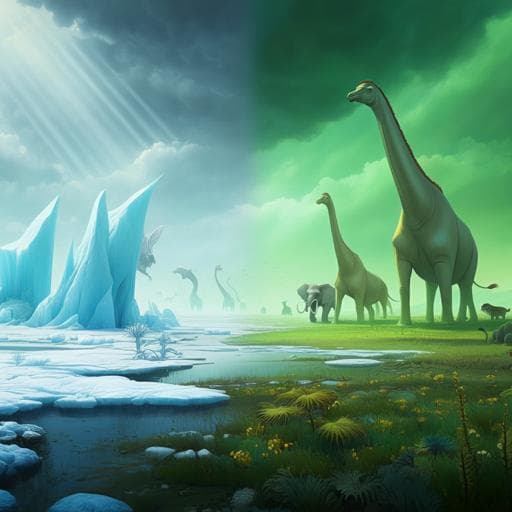
Earth Sciences
Rapid range shifts and megafaunal extinctions associated with late Pleistocene climate change
F. V. Seersholm, D. J. Werndly, et al.
Discover groundbreaking insights from researchers Frederik V. Seersholm, Daniel J. Werndly, Alicia Grealy, and others, as they unveil the impact of climatic shifts at the Pleistocene-Holocene boundary on Texas' ecosystems. Their ancient DNA study reveals dramatic drops in local diversity and the mystery behind the megafauna's disappearance. Dive into the fascinating history of Earth's changing environments!
~3 min • Beginner • English
Introduction
The study addresses the long-standing debate about the causes of late Quaternary megafaunal extinctions, focusing on disentangling the relative roles of climate change and human impacts in North America where these events occurred nearly simultaneously. The authors investigate how rapid climatic fluctuations—from Bølling-Allerød warming to Younger Dryas cooling and into the early Holocene—affected biodiversity at a local scale. They aim to quantify the pace and extent of ecosystem responses across the Pleistocene-Holocene transition using high-resolution ancient DNA records from Hall's Cave, Texas, to provide insights into whether climate alone can explain megafaunal losses, or whether additional factors (e.g., human hunting) were necessary.
Literature Review
Two main hypotheses dominate explanations for late Quaternary extinctions: human hunting and climate change, with other ideas (disease, extraterrestrial impacts) less supported. Archaeological evidence shows Paleo-Indian groups hunted at least six of 36 megafaunal genera in North America, supporting a role for humans, although small early populations leave uncertainty about the magnitude of hunting pressure. The widely cited “one-two punch” hypothesis posits combined climate and human effects leading to extinctions circa 13.0–12.5 ka cal BP. Unlike Australia and New Zealand where human arrival and climate shifts are decoupled, North American climate changes coincided with human arrival, complicating attribution. Greenland ice-core records document Bølling-Allerød warming followed by Younger Dryas cooling (12.9–11.7 ka cal BP), but translating these to central North America is debated; estimates for YD severity range from near-glacial to ~5°C cooler than present, with increased seasonality a possible factor. Fossil and pollen records spanning this critical interval are rare, limiting prior assessments.
Methodology
Study site and chronology: Hall's Cave (Edwards Plateau, central Texas) contains a finely stratified, well-dated sedimentary sequence from the Last Glacial Maximum (LGM) to present. An age-depth model (Clam 2.3.2 in R) using 23 published radiocarbon dates (two outliers removed) and a smooth spline provided calibrated ages for samples. The onset of the Younger Dryas (YD) was defined at the base of an organic-rich “Rancholabrean mat” at 151 cm below datum, dated to 12.6 ka cal BP.
Sampling design: Samples were grouped into four climatic intervals: (1) LGM (ca. 20–14.7 ka cal BP), (2) Bølling-Allerød (B-A; 14.7–12.6 ka cal BP), (3) Younger Dryas (12.6–11.7 ka cal BP), and (4) Early Holocene (EH; 11.7–8.0 ka cal BP). Bulk-bone material was excavated across the profile; sediments were collected from two closely spaced sequences spanning B-A through YD to EH.
Ancient DNA approaches: Two complementary aDNA methods were used. (i) Bulk-bone metabarcoding (BBM) targeted vertebrate mitochondrial markers 12S rRNA and 16S rRNA across 30 newly excavated bulk-bone samples (~100 small nondiagnostic bones per sample) and six additional bulk-bone samples from large fragmentary fossils excavated in 1993. Total reads: 12S = 2,313,843; 16S = 2,315,462. (ii) Sedimentary aDNA (sedaDNA) targeted plant chloroplast loci trnL (P6 loop) and rbcL from 32 sediment samples, generating 2,066,643 reads (trnL: 828,118; rbcL: 1,111,635). Ten sediment samples were also assayed with vertebrate primers to compare vertebrate detection between bone and sediments.
Laboratory protocols: All work was performed in dedicated aDNA facilities with contamination controls. Bulk-bone fragments were cleaned, weighed, homogenized, and extracted using a modified Dabney et al. protocol with proteinase K/EDTA digestion, ultrafiltration, and silica column purification. Sediment DNA extraction was optimized for sediments with similar steps and combined replicates. PCR amplifications were performed in duplicate with indexed primers, 50 cycles, pooled equimolar, size-selected (160–450 bp), and sequenced on Illumina MiSeq (single-end) with custom primers.
Bioinformatics and taxonomic assignment: Sequences were demultiplexed and processed with an OBITools-based pipeline: length and abundance filtering, denoising (obiclean), clustering (sumaclust), chimera filtering (vsearch uchime_denovo). ASVs were assigned taxonomically using BLAST (megablast/blastn) against NCBI nt, parsed with a lowest common ancestor approach (getLCA). Plant assignments were limited to genera present in the contiguous USA; minimum assignment level was genus. Filtering thresholds differed for plant assays (retain ASVs ≥20 bp, ≥5 reads, and present in ≥3 samples).
Statistical analyses: Alpha-diversity per layer and non-metric multidimensional scaling (NMDS) ordinations were computed in R (vegan), using presence/absence of identified taxa (contaminants/redundant taxa removed). Taxonomy-independent ordinations used ASV tables. Habitat niche inference used IUCN range maps and WorldClim v2 (10′ resolution) to estimate realized temperature niches for selected indicator species (e.g., Lepus townsendii, Onychomys spp., Sigmodon spp.).
Quality and preservation: Assessments found no systematic changes in DNA preservation through time; thus observed temporal patterns are interpreted as ecological rather than preservation artifacts, with acknowledgment of general taphonomic influences.
Key Findings
- Taxonomic richness and composition:
• At least 100 vertebrate species detected via BBM: 50 mammals, 36 birds, 9 amphibians, 3 reptiles, 2 fishes; assemblage largely consistent with prior osteology but with added resolution (e.g., Neotoma to species) and many new non-mammal records.
• Plant sedaDNA revealed diverse flora dominated by Celtis (hackberry) and Quercus (oak); several arboreal taxa (e.g., Juniperus, Juglans, Fraxinus) occur discontinuously.
• Vertebrate DNA in sediments frequently detected felids (Panthera onca, Lynx rufus), suggesting felid presence and DNA deposition via non-bone sources.
- Community turnover and diversity shifts:
• NMDS shows significant clustering by time period for vertebrates (P < 0.001, 999 permutations). For plants, Bølling-Allerød clusters distinctly from YD and EH (P < 0.001), with trnL resolving periods better than rbcL.
• Vertebrate alpha-diversity declined markedly from LGM/B-A (mean 20.0 ± 3.8 taxa per layer) to YD/EH (mean 9.8 ± 2.0; t-test P = 1.739e-09). Declines observed in birds, reptiles/amphibians, carnivores, and large herbivores, but not small mammals.
• Plant alpha-diversity declined from B-A (mean 21.7 ± 7.9) to YD (mean 10.1 ± 6.8; t-test P = 0.0005), then increased in EH (mean 15.5 ± 8.2) with returns of warm-climate taxa and new immigrants (e.g., Commelina, Cercis).
- Biogeographic and climatic inferences:
• Small-mammal range shifts track temperature oscillations: cold-adapted species (e.g., Onychomys leucogaster, Lepus townsendii) present in LGM, retreat during B-A warmth, reappear during YD, and disappear with EH warming; warm-adapted taxa (e.g., Lepus californicus, Onychomys arenicola, Sigmodon spp.) appear with warming.
• Temperature estimates from realized niches suggest mean annual temperature in central Texas was <10.6°C during LGM (upper niche limit of L. townsendii) and rose above ~11°C by early Holocene (lower limits for Sigmodon and O. arenicola).
- Hydro-edaphic changes and denudation:
• Loss of fossorial and wetland taxa indicates drying and soil thinning from LGM to Holocene. Prairie dog (Cynomys) present only in LGM suggests >100 cm soils pre-14.7 ka; subsequent disappearances of Marmota and Scalopus indicate progressive reductions to <25 cm by YD, consistent with strontium isotope evidence for massive late Quaternary soil denudation.
- Vegetation dynamics and proxy comparisons:
• BBM and sedaDNA together indicate transition from mesic grassland (LGM) to open woodland (B-A), then drier live oak–juniper woodland (EH). Prairie chicken disappearance at B-A with appearance of woodland birds (Colinus, Meleagris) supports increasing tree cover.
• SedaDNA lacks Pinus despite abundant Pinus pollen, reflecting local origin of sedaDNA versus long-distance, overrepresented Pinus pollen; overall vegetation trends align across proxies (pollen, phytoliths, faunal remains, isotopes).
- Megafaunal losses and trophic collapse:
• Five extant and nine extinct large-bodied taxa disappeared locally at the end of the Pleistocene. Large grazers (camel, helmeted muskox, horses, pronghorn) and their predators (Smilodon, Arctodus) vanish with grassland loss, indicating trophic collapse.
• Non-analog faunas in Pleistocene strata (e.g., co-occurrence of species not found together today) indicate fundamentally different community assemblies.
• The last extinct taxon detected (Haringtonhippus francisci) occurs at 153 cm (~12.7 ka cal BP), at the onset of the YD.
- Differential recovery:
• Plant diversity recovered post-YD as climate warmed; vertebrate diversity, especially large mammals, did not recover, suggesting additional pressures (e.g., human hunting) beyond climate.
Discussion
The integrated aDNA records from bones and sediments reveal rapid, climate-linked ecological reorganization across the Pleistocene–Holocene transition at Hall's Cave. Both plants and vertebrates suffered diversity declines during the Younger Dryas, consistent with abrupt cooling and drying, soil loss, and habitat shifts. However, recovery trajectories diverged: plant diversity and warm-adapted taxa returned with early Holocene warming, whereas vertebrate diversity—particularly large-bodied mammals—remained depressed. Small mammals tracked climate dynamically via range shifts, paralleling plant responses, implying that climate alone does not explain the permanent loss of large mammal diversity. The persistence of low large-mammal diversity post-YD, despite plant recovery and warming, supports a combined-impact scenario in which human hunting pressure, coincident with climatic upheaval, contributed to megafaunal extinctions and a trophic collapse. Proxy comparisons highlight the importance of local versus regional signals (sedaDNA vs pollen), yet converge on a consistent narrative of vegetation change from mesic grassland to woodland and increased denudation. These findings refine our understanding of extinction drivers by showing that local ecosystem restructuring occurred rapidly and that biotic responses were taxon-specific, governed by life history, body size, and human susceptibility.
Conclusion
This study provides a high-resolution, local aDNA record documenting rapid range shifts, vegetation transitions, and differential biodiversity responses to late Pleistocene climate change in central Texas. It demonstrates that plant communities recovered following Younger Dryas cooling, whereas vertebrate diversity—especially large-bodied mammals—did not, implicating factors beyond climate, likely including human hunting, in megafaunal extinctions. The work reconciles multiple proxies (aDNA, faunal assemblages, pollen, phytoliths, isotopes) and quantifies associated environmental changes such as soil denudation and drying. Future research should expand to multi-proxy, multi-site frameworks integrating single-bone mitogenomes/whole genomes, bulk-bone aDNA, stable isotopes, targeted 14C dating, archaeology, pollen, diatoms, and microstratigraphy to better resolve timing, causation, and ecosystem dynamics across regions and taxa.
Limitations
- Site-specific inference: conclusions derive from a single well-preserved locality (Hall's Cave); broader generalization requires additional sites.
- Chronological uncertainty: slight mismatch between defined YD onset (12.6 ka cal BP) and canonical 12.9 ka could reflect age-depth model uncertainty or younger contamination (e.g., humic acids).
- Taphonomic and preservation biases: although no temporal trend in DNA preservation was detected, all fossil deposits are subject to taphonomic influences that may skew assemblages.
- Taxonomic resolution limits: plant rbcL assay has low resolution; sedaDNA may miss taxa with low local biomass or low chloroplast DNA in pollen (e.g., Pinus).
- Detection biases between substrates: vertebrate detection differs between bones and sediments (e.g., felids), reflecting differential DNA sources (hair, feces, urine) and depositional behaviors.
- Climate inference assumptions: temperature reconstructions based on modern realized niches may not fully capture past niche shifts or microclimate heterogeneity.
Related Publications
Explore these studies to deepen your understanding of the subject.







